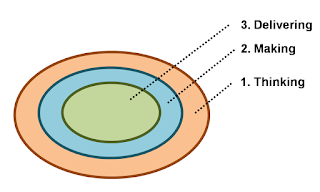Brian Miller is a magician (and an entertainer) who spoke at TEDx recently. His talk has already garnered close to 200,000 views on YouTube. JazzFactory caught up with Brian Miller and tried to understand how he went about preparing his amazing TEDx talk. His talk is short, engaging and has no slides. You can watch him speak here.
JazzFactory: Who was the audience you had in mind while preparing your talk? The global audience of TED or the immediate audience at the event?
Brian Miller: The audience I cared most about was the potential global audience of YouTube viewers. TEDx conferences are limited to 100 attendees, and therefore they represent the smallest potential audience for your speech. The real beauty of TED and TEDx talks is that they are capable of reaching thousands, hundreds of thousands, and even millions of people around the world. I designed the speech and rehearsed it with that goal in mind.
JazzFactory: You are a performer. Did you still have butterflies in your stomach when you went on stage?
Brian: I am a seasoned performer / speaker, having performed for over 10 years in front of 1000s of audiences. For that reason, I am hardly nervous when I go on stage. This event, however, did make me nervous. The TED brand carries so much prestige that I was overcome with the pressure to do a magnificent job. I knew that if I could give a truly great talk, it had the potential to significantly boost my speaking career (and it has).
JazzFactory: How much time were you given to prepare? How much time you actually took to prepare?
Brian: I had about 6 weeks from the time I was invited to speak until the actual conference date, and I used all of that time.
JazzFactory: How did you prepare the content and decide on the flow?
Brian: I read books about giving speeches including How to Give a TED Talk by Jeremey Donovan, and watched so many TED and TEDx talks. I took notes on what I liked and what worked, and most importantly what didn’t. My speech was structured in a very traditional way, by using story vignettes to support my main points.
JazzFactory: Why did you not use slides?
Brian: The option to use slides was available, but I have never used slides for a presentation. Personally I feel that slides are more often distracting to an audience than they are useful. Most importantly, slides seem to create a barrier between the speaker and the audience. It is crucial to maintain an authentic relationship with the audience, especially in a TED-style talk, and for those reasons I chose not to use slides.
Brian: After I finished writing the speech word for word and finalizing the draft, I rehearsed by reading it out loud over and over again, and always timed myself. I made notes and adjustments to the script based on those sessions and eventually found myself rehearsing without the need for a script. I would say I rehearsed the speech nearly 150 times by the day of the talk.
JazzFactory: What advice would you give to people who are preparing for their upcoming TEDx talk?
Brian: Watch as many TED and TEDx talks as you can, and take notes while doing so. Study those who have gone before you for what you think works and doesn’t work. Then use that information while crafting your speech. Rehearse until you can do the talk without thinking about it. TEDx is not the time to “wing it” from an outline. It should be polished and near-perfect. Most importantly: speak about something you care about deeply. Audiences respond to passion, and it is infectious. If you’re passionate about your topic, the audience will be inclined to listen.
We thank Brian for taking out time and sharing his secrets with us. If you want to know more about his preparation, check out his blog. Read the post here.
























